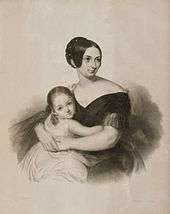Carolyne zu Sayn-Wittgenstein

Princess Carolyne zu Sayn-Wittgenstein (February 8, 1819 – March 9, 1887[1]) was a Polish noblewoman who pursued a 40-year liaison/relationship with Franz Liszt. She was also an amateur journalist and essayist, and it is conjectured that she did much of the actual writing of several of Liszt's publications, especially his Life of Chopin. She pursued an enormous correspondence with Liszt and many others, which is of vital historical interest. She admired and encouraged Hector Berlioz, as is clear from their extensive correspondence. Berlioz dedicated Les Troyens to Princess Carolyne.
Biography

Karolina Elżbieta Iwanowska was born at Woronińce (today Voronivtsi (Воронівці), Ukraine) in one of her parents' many estates in eastern Poland, then a province of the Russian Empire. On April 26, 1836, just two months after her 17th birthday (and with pressure from her father), Carolyne married Prince Nikolaus zu Sayn-Wittgenstein-Berleburg-Ludwigsburg (1812–1864), an officer in the Russian service who was also a member of an ancient noble house as the son of Peter Wittgenstein.[2] They had an only daughter, Marie Pauline Antoinette (1837–1920), who later married Prince Konstantin zu Hohenlohe-Waldenburg-Schillingsfürst (brother of Prince Chlodwig zu Hohenlohe-Schillingsfürst, foreign minister of the Kingdom of Bavaria until its unification with the German Empire).
Princess Carolyne met Franz Liszt in 1847 during one of his musical tours in Russia. The princess, a strong Roman Catholic, had by then been estranged from her husband for some time. She and Liszt began living together at Weimar from 1848. Eventually she wished to regularise their situation and marry Liszt, but since her husband was still living, she had to convince the Roman Catholic authorities that her marriage to him had been invalid. After an intricate process that involved two direct papal audiences, she temporarily was successful (September 1860), and the couple planned to marry in Rome on October 22, 1861, Liszt's 50th birthday. Liszt arrived in Rome the previous day, only to find the princess unable to marry him. It appears that both her husband and the tsar of Russia managed to quash permission for the marriage at the Vatican. The Russian government also impounded her several estates (she owned thousands of serfs), which made her later marriage to Liszt, or anyone, unfeasible. Furthermore, the scandal would have seriously harmed her daughter's marriageability, clearly the main reason why the prince put an end to his wife's scheduled remarriage.
Subsequently her relationship to Liszt became one of platonic companionship, especially after he received minor orders in the Catholic Church and became an abbé. For her part, Carolyne spent several decades in Rome writing privately (and very critically) on church issues. She was devastated by Liszt's death and survived him only a few months, dying on March 9, 1887 in Rome.
Works
Carolyne zu Sayn-Wittgenstein was a prolific writer, but most of her works were privately printed; the chief of these was Des causes intérieures de la faiblesse extérieure de l'Église (the title could be translated as "The Inward Reasons for the Church's Outward Weakness"), a massive 24-volume undertaking. The book was placed on the Index Librorum Prohibitorum,[3] the Catholic Church's list of banned books.
A posthumous publication was La vie chrétienne au milieu du monde et en notre siècle. Entretiens pratiques recueillis et publiés par Henri Lasserre, Paris 1895.
References
- ↑ Walker, Alan (1997). Franz Liszt: The Final Years, 1861-1886 at Google Books. Cornell University Press. page 536. ISBN 0-8014-8453-7.
- ↑ "Genealogisches Handbuch der baltischen Ritterschaften, Teil 2, 3: Estland", Görlitz. 1930. p. 297
- ↑ Index librorum prohibitorum Archived 2007-02-03 at the Wayback Machine. von 1948.
Further reading
- Francesco Barberio, Liszt e la Principessa de Sayn-Wittgenstein, Roma: Unione Editrice 1912.
- Hector Berlioz, Lettres à la princesse, Paris: L'Herne 2001 (correspondence with the princess Sayn-Wittgenstein) (in French).
- Briefe von Hector Berlioz an die Fürstin Caroline Sayn-Wittgenstein (hrsg. v. La Mara), Leipzig: Breitkopf & Härtel 1903.
- Ideale Freundschaft und romantische Liebe. Briefe an die Fürstin Carolyne Sayn-Wittgenstein und Frau Estelle Fornier (hrsg. v. La Mara; = Literarische Werke, Bd. 5), a.d. Frz. v. Gertrud Savić, Leipzig: Breitkopf & Härtel 1903.
- Marcel Herwegh, Au Soir des dieux ; Des derniers reflets Wagneriens à la mort de Liszt , Paris: Peyronnet 1933.
- La Mara (i.e. Marie Lipsius, Hrsg.), Franz Liszt's Briefe an die Fürstin Carolyne Sayn-Wittgenstein, Leipzig: Breitkopf & Härtel 1899 (in French)
- La Mara (i.e. Marie Lipsius, Hrsg.), Aus der Glanzzeit der Weimarer Altenburg. Bilder und Briefe aus dem Leben dem Fürstin Carolyne Sayn-Wittgenstein, Leipzig: Breitkopf & Härtel 1906.
- La Mara (i.e. Marie Lipsius, Hrsg.), An der Schwelle des Jenseits. Letzte Erinnerungen an die Fürstin Carolyne Sayn-Wittgenstein, die Freundin Liszts, Leipzig: Breitkopf & Härtel 1925.
- Émile Ollivier, Correspondance. Emile Ollivier et Carolyne de Sayn-Wittgenstein, Paris: Presse univérsitaire 1984.
- Sammlung von Handzeichnungen aus dem Besitze der Fürstin Carolyne Sayn-Wittgenstein (1819-1889), München: Emil Hirsch, Antiquariat, 1922.
- Adelheid von Schorn (Hrsg.), Zwei Menschenalter. Erinnerungen und Briefe, Berlin: S. Fischer 1901.